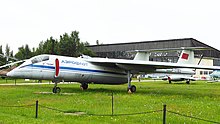
The Mikoyan-Gurevich MiG-25 is a supersonic interceptor and reconnaissance aircraft that is among the fastest military aircraft to enter service. Designed by the Soviet Union's Mikoyan-Gurevich bureau, it is an aircraft built primarily using stainless steel. It was to be the last plane designed by Mikhail Gurevich, before his retirement.

The Tupolev Tu-110 was a jet airliner designed and built in the USSR, which saw its maiden flight in 1957.

The Myasishchev M-4 Molot was a four-engined strategic bomber designed by Vladimir Mikhailovich Myasishchev and manufactured by the Soviet Union in the 1950s to provide a Long Range Aviation bomber capable of attacking targets in North America.
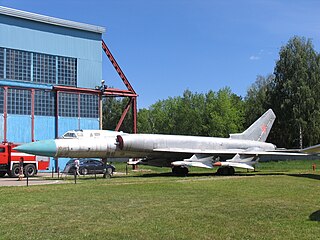
The Tupolev Tu-28 was a long-range interceptor aircraft introduced by the Soviet Union in the 1960s. The official designation was Tu-128, but this designation was less commonly used in the West. It was the largest and heaviest fighter ever in service.

The Yakovlev Yak-28 is a swept wing, turbojet-powered combat aircraft used by the Soviet Union. Produced initially as a tactical medium bomber, it was also manufactured in reconnaissance, electronic warfare, interceptor, and trainer versions, known by the NATO reporting names Brewer, Brewer-E, Firebar, and Maestro respectively. Based on the Yak-129 prototype first flown on 5 March 1958, it began to enter service in 1960.
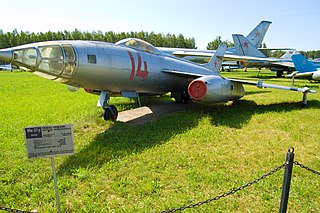
The Yakovlev Yak-27 was a family of Soviet supersonic aircraft developed in 1958 from the Yak-121 prototype. The most built variant was the tactical reconnaissance Yak-27R.

The Bell X-16 was a high altitude aerial reconnaissance jet aircraft designed in the United States in the 1950s. The designation of X-16 was a cover to try to hide the true nature of the aircraft mission from the Soviet Union during the Cold War.
V. M. Myasishchev Experimental Design Bureau or OKB-23, founded in 1951 by MGB UdSSR Vladimir Myasishchev, was one of the chief Soviet aerospace design bureaus until its dissolution in 1960. Vladimir Myasishchev went on to head TsAGI. In 1967, Myasishchev left TsAGI and recreated his bureau, which still exists to this day. The bureau prefix was "M." As of 2003, its workforce is estimated at approximately one thousand. Myasishchev and NPO Molniya intend to use the V-MT or M-55 as launch vehicle for sub-orbital spaceflight.

The Mil V-12, given the project number Izdeliye 65, is a prototype helicopter designed in the Soviet Union and the largest helicopter ever built. The designation "Mi-12" would have been the designation for the production helicopter and did not apply to V-12 prototypes.

The Myasishchev M-50 is a Soviet prototype four-jet engine supersonic strategic bomber which never attained service. Only one flightworthy prototype was built, which was first flown in October 1959. The M-50 was constructed by the Myasishchev design bureau.

The Soloviev D-30 is a Soviet two-shaft low-bypass turbofan engine, officially referred to as a "bypass turbojet". It is one of the most powerful turbofan engines developed in the Soviet Union. Development of the turbofan spurred numerous growth versions with increased fan diameter and modified component arrangements. Developed in a short period of time, the D-30 turned out to be one of the most reliable engines in the history of Soviet engine development, and it was recognized with the USSR State Prize.
The Kuznetsov Design Bureau was a Russian design bureau for aircraft engines, administrated in Soviet times by Nikolai Dmitriyevich Kuznetsov. It was also known as (G)NPO Trud and Kuybyshev Engine Design Bureau (KKBM).

The Myasishchev VM-T Atlant was a variant of Myasishchev's M-4 Molot bomber, re-purposed as a strategic-airlift airplane. The VM-T was modified to carry rocket boosters and the Soviet space shuttles of the Buran program. It is also known as the 3M-T.
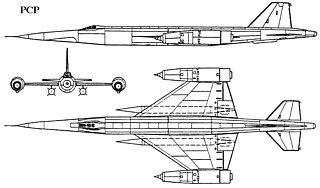
The Tsybin RSR was a Soviet design for an advanced, long-range, Mach 3 strategic reconnaissance aircraft.

This listing of flight altitude records are the records set for the highest aeronautical flights conducted in the atmosphere, set since the age of ballooning.
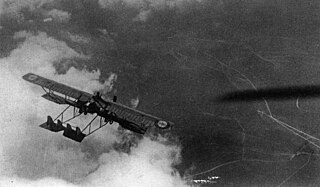
The Caudron G.4 was a French biplane with twin engines, widely used during World War I as a bomber. It was designed by René and Gaston Caudron as an improvement over their single-engined Caudron G.3. The aircraft employed wing warping for banking. The first G.4 was built in 1915, and it was manufactured in France, England and Italy. It was the world's first twin-engine aircraft to be widely used, starting in March 1915.
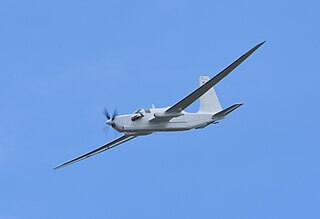
The Grob G 520 is a turboprop long-endurance, high-altitude reconnaissance and surveillance aircraft built by Grob Aircraft with short runway capabilities and full approval for all-weather IFR/icing operations according to LBA/FAA Part 23 regulations. Developed and certified in 1991, the Grob G 520 is one of the world's largest fully composite manned aircraft and holder of several world records. Production was resumed in 2014.

The Kolesov RD-36 was a supersonic turbojet engine used on various Soviet aircraft projects.
The Beriev S-13 was a Soviet reverse-engineered copy of the Lockheed U-2C, developed in the Soviet Union in the early 1960s.

